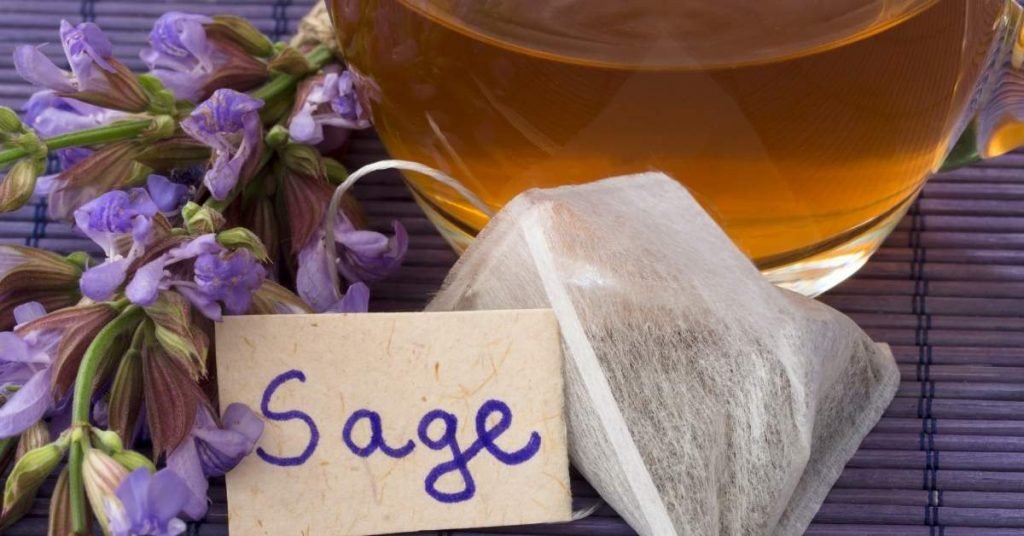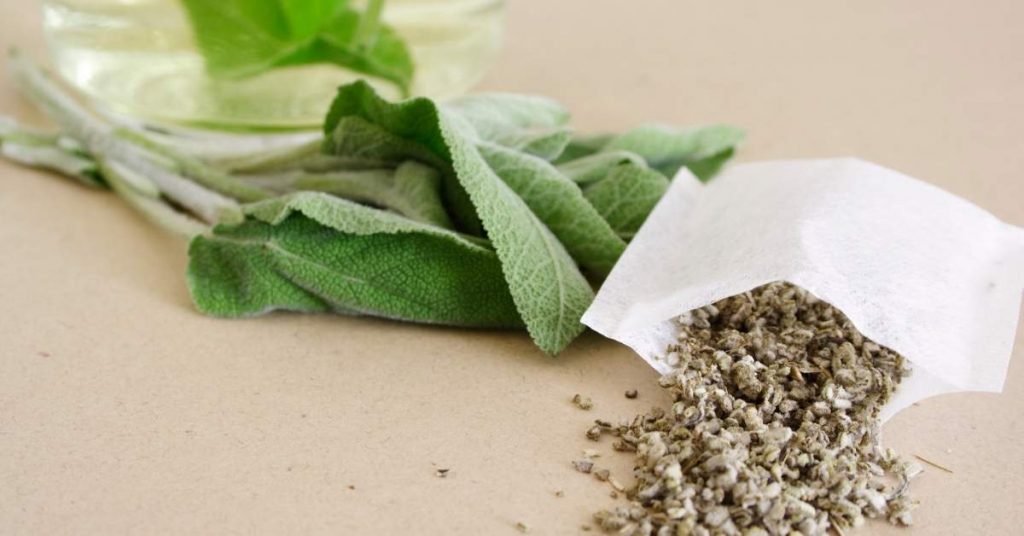Sage is an evergreen shrub plant with green-greyish leaves, native to the Mediterranean region.
However, this medicinal plant exists in many parts of the world and it is quite easy to propagate.
Member of the mint family, sage is packed with many medicinal properties and it’s often used for tea preparation.
Sage boasts an earthy flavor with hints of eucalyptus, mint, and lemon.
Sage Tea Benefits

Sage is a herbal tea packed with antioxidant and anti-inflammatory properties that aid human health.
- Powerful antioxidant. Sage is rich in rosmarinic acid which works as a free radical combating agent and lowers blood sugar levels.
- Promotes healthy skin. Sage is rich in camphor, a compound that promotes healthy skin cell growth and stops premature aging.
- Promotes oral health. Sage is often connected to healing sore throat and mouth wounds thanks to the potent rosmarinic acid.
- Anti-cancer properties. Sage is rich in carnosol, a compound that inhibits cancer cell growth and reduction of tumors.
- Regulates blood sugar levels. Sage tea is perfect for regulating blood sugar levels and preventing type 2 diabetes.
The information presented on this site is provided for information purposes only. It is not meant to substitute for medical advice or diagnosis provided by your physician or other medical professionals. Do not use this information to diagnose, treat, or cure any illness or health condition. If you have or suspect that you have a medical problem, contact your physician or healthcare provider.
When Should I Drink Sage Tea?
Sage tea is a flavorful, caffeine-free herbal drink that you can drink at any time of the day, without disrupting your sleeping patterns.

Can I Drink Sage Tea Every Day?
Yes, you can have sage tea every day, especially if you’re suffering from oral infections and sore throat.
Sage tea has soothing properties and is excellent for disinfecting the oral cavity.
The recommended dosage of sage tea for treating an oral infection is three cups per day.
Is Sage Tea Good for Weight Loss?
Sage is low in calories but it can also increase the appetite in some people, so it’s probably not the best tea for weight loss.
The tea itself is extremely healthy for overall human health, the only problem is that its earthy flavor might provoke you to eat some sugary sweet afterward.
What Do Sage Leaves Do to Your Body?
Sage is rich in multiple compounds connected to increased brain function, memory improvement, reducing tumor growth, and combating free radicals.
These compounds include rosmarinic acid, caffeic acid, chlorogenic acid, and ellagic acid.

Dry Sage vs. Fresh Sage for Tea
There is no doubt that dried sage wins the battle against fresh sage leaves both in tea and in cooking.
Dried sage has a more intense flavor and it’s easier to manipulate, available as a whole dry leaf, rubbed, and ground.
If you’re looking for the best sage option for brewing, then whole leaf sage is what you need for a good cuppa.
How Many Sage Leaves Make a Cup?
One teaspoon of chopped dry sage leaves is enough for a cup of tea, which means 3-4 dry leaves.

Can I Use Fresh Sage for Tea?
Yes, but you will need double the amount of leaves. Fresh sage is extremely aromatic but not like its dried counterpart, so you need to add more of it for a full-flavor tea.
How to Make Sage Tea?
Pour a cup of boiling water over a tsp of dry sage leaves and steep for a few minutes. The more you steep, the stronger your infusion will be.
Strain and add sweetener to your liking.
Final Word
Sage is an excellent herb for any garden, balcony, and even kitchen shelf.
It’s easy to cultivate, packed with medicinal properties, and it’s good for tea and culinary experiments.
Boost your oral health and keep your blood sugar levels under control by adding sage tea to your daily routine.
MEDICAL DISCLAIMER
Itsnevernotteatime.com cannot and does not contain medical/health advice. The medical/health information is provided for general and educational purposes only and is not a substitute for professional advice.




